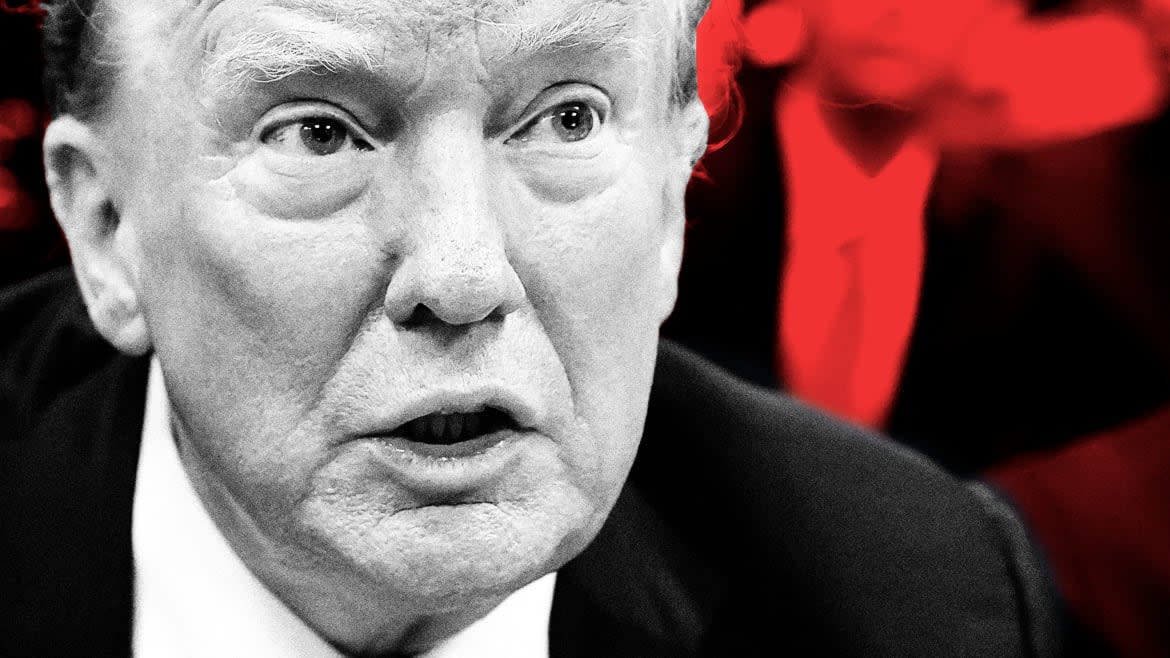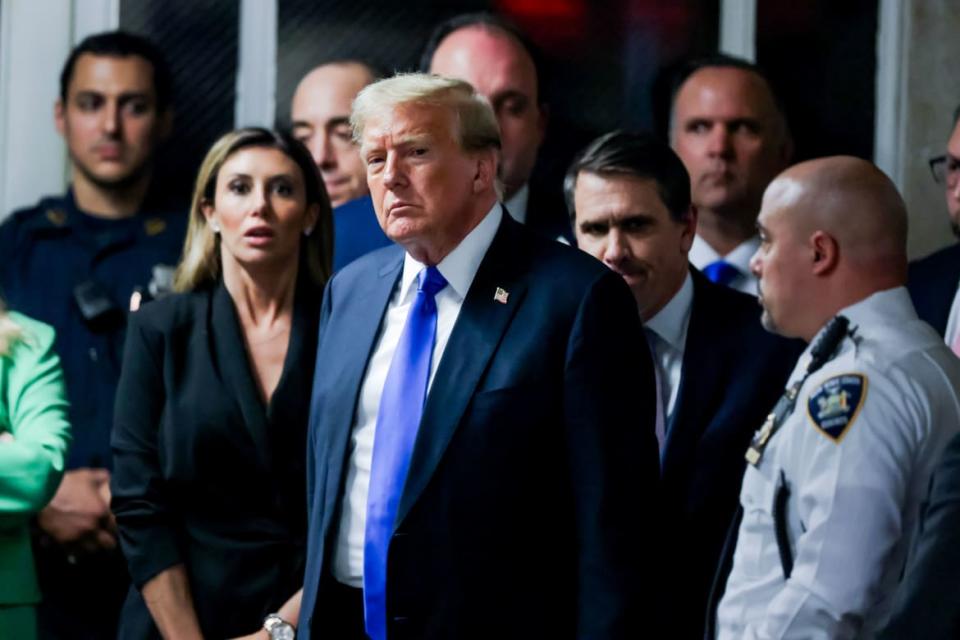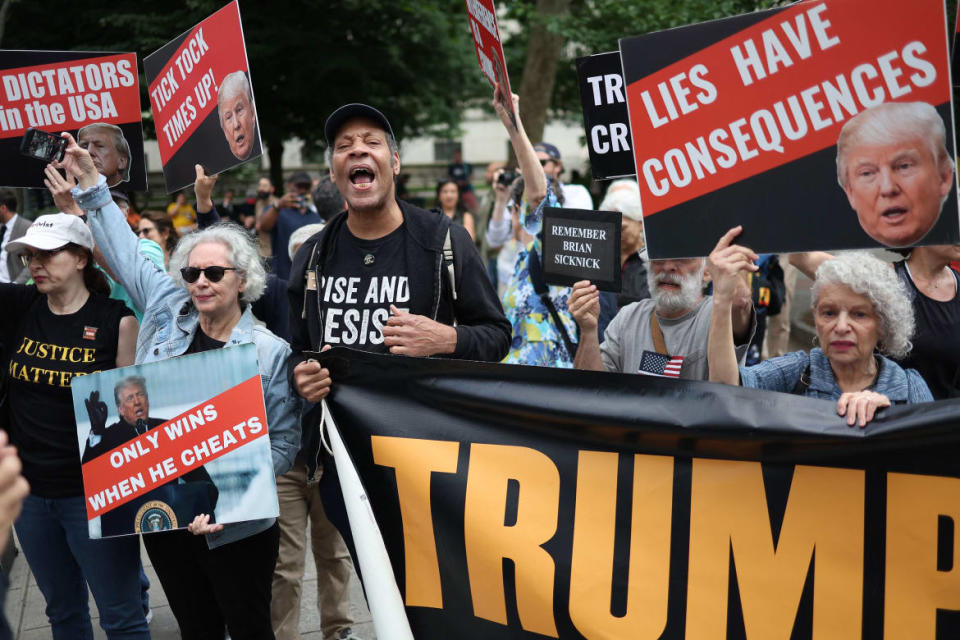GUILTY ON ALL COUNTS! Trump a Convicted Criminal

Donald Trump is now a convicted criminal—an ignominious distinction added to his increasingly notorious profile: bank fraudster, sexual abuser, and aspiring authoritarian.
His seven-week trial in Manhattan ended on Thursday with a swift verdict that found him guilty on all 34 felony counts of falsifying business records. The jury deliberated for nine-and-a-half hours, with the results announced at 5:07 p.m. on the second day of discussions behind closed doors.
Trump didn’t move as the jury foreman read out the verdicts; the foreman appeared short of breath as he read out the first few, and his voice grew weak as he reached count 10. After all 34 were read out, the former president simply licked his lips and chewed despite having nothing in his mouth.
As New York Supreme Court Justice Juan Merchan then thanked the jurors for spending time away from their jobs and families, and for engaging in a “very stressful and difficult task,” Trump cocked his head to the right.
None of the jurors looked at him as they filed out of court, and Trump merely puffed out his chest and arched his back. Merchan then set a sentencing date of July 11.
With his face now red and marked by a frown, Trump shook his son Eric’s hand, licked his lips, and prepared to walk out of the room, past some 80 journalists staring him down. He kept his eyes fixed on the double doors at the end of the aisle for a walk that lasted five seconds but seemed to take forever.
Trump After Verdict: Rigged, Rigged, Rigged, Rigged, Etc.
Before the decision came in, all signs pointed to jurors actively discussing the merits of the case by closely examining the finer details buried amidst the most damning evidence. Three-and-a-half hours in on Wednesday, jurors buzzed the courtroom with a request to read transcripts of courtroom testimony by David Pecker, the media executive who employed his National Enquirer supermarket tabloid in catch-and-kill operations to silence two of Trump’s paramours. They wanted to see exactly what Pecker recalled about his 2015 meeting at Trump Tower and a hush-money deal phone call that interrupted his meeting with investors in 2016. An hour later, they asked the judge to re-read his instructions—an hour-long exercise.
Trump, whose name is emblazoned on luxury towers and golf courses around the world, has cemented his place in history as the first former American president who became a convicted crook. His crime—despite the breathless critiques of his most ardent supporters—was not having sex with a porn star named Stormy Daniels, nor was it paying for her silence. It was the faked paperwork that sought to hide it all from the public on the eve of the 2016 presidential election.
The common refrain is that the cover-up is worse than the crime. In this case, the cover-up was the crime, as local prosecutors employed Penal Law § 175.10, a New York state rule that specifically punishes people for faking business paperwork to conceal another crime—in this instance, election interference.

Donald Trump departs the courtroom after being found guilty on all 34 counts in his hush money trial.
The question now is whether the man who spent four years living in the White House will serve time behind bars, either at the metropolis’ notorious Rikers Island jail or a prison upstate. Merchan will decide on that later.
The judge is contending with the most unusual of defendants, a man poised to once again lead the federal government if he wins the presidential election in November despite his incessant attempts to destroy the citizenry’s confidence in the nation’s justice system.
As jurors deliberated Wednesday afternoon, Trump posted on his Truth Social media network: “According to the Legal Scholars and Experts, the Jury Instructions, given by a highly Conflicted Judge, will go down as the most biased and unfair in Judicial History. Biden Witch Hunt. Election Interference!!!”
The business tycoon, who built his flashy real estate empire, boisterous media personality, and belligerent political movement entirely on the perceptions of average Americans, had his fate ultimately decided by them as well.
For all his conspiratorial talk about the case being a “rigged” political prosecution, the final decision was made by a diverse band of everyday New Yorkers that included a teacher, a lawyer, and an engineer. On the final day of trial, he wore black oxfords. They wore gray sneakers, blue loafers, and tan sandals. He wore suits. They wore sweaters, polos, and jeans.
Contrary to the incendiary claims on right-wing news networks, jurors did not seem to have their minds made up from the start. After each promising to give Trump a fair shake when they were selected in mid-April from more than 100 candidates, they made time-consuming requests of the attorneys on the first day of deliberations by asking to take a closer look at exactly what Trump’s interactions were with Pecker at particular moments in the run-up to these hush-money deals. It was also notable that they asked for three segments of Pecker’s testimony and only one belonging to former Trump confidant Michael Cohen, the key witness whose history of lying under oath and tricking journalists posed a significant problem for prosecutors. In fact, the only Cohen testimony they wanted to review was the disgraced lawyer’s recollection of meeting Trump and Pecker at Trump Tower in August 2015, when the media executive laid out his commitment to support the Republican’s longshot candidacy.

People react outside of the Manhattan Criminal Courthouse after former Donald Trump's conviction.
Trump defense lawyers Todd Blanche, Susan Necheles, and Emil Bove directed all their energy into a concerted effort that sought to eviscerate any shred of credibility in two of the trial’s key witnesses: Cohen and Daniels. Sure, they were both easy targets. One is a convicted liar and the other makes raunchy movies. The lawyers tried to turn cross-examinations into boxing sessions with a punching bag. Blanche exposed Cohen’s refusal to fully accept responsibility for his past mistakes, while Necheles settled with cheap shots at the porn star.
“So, you have a lot of experience in making phony stories about sex appear to be real, right?” Necheles asked on a day in early May, sparking courtroom gasps.
But as the eventual verdict shows, it didn’t work. Daniels’ defiance proved convincing when she responded, “The sex in the films, it’s very much real. Just like what happened to me in that room.”
And as they considered Trump’s guilt, jurors sat on a colossal trove of evidence. The prosecution’s numbered exhibits stretched into the 400s, with a dizzying array of phone logs that hinted at a coordinated cover up campaign, the emails and texts and bank records that meticulously tracked how Cohen set up a shell company and negotiated a nondisclosure agreement and fronted the hush money, the FedEx slips that showed how Cohen’s invoices for fake legal work were discreetly routed to Trump while he led the federal government, and the dirty checks signed by a president on the Oval Office’s famed Resolute desk.
The exact classification of the criminal charges, like the dreary civil-service setting of this trial, belied the true nature of this historic moment in American history. Even the most stringent version of “falsifying business records” is a class E felony, the absolute lowest tier on the books. A convicted criminal can theoretically face up to four years in prison, but in reality will probably get a stern lecture from the judge and probation—if that.
But beneath the surface, this was always more than a dispute over forged documents. At trial, prosecutors Susan Hoffinger, Joshua Steinglass, and Becky Mangold kept drawing jurors’ attention to the true purpose of the entire scheme: duping voters by burying dirt. The irony, of course, is that the politician who accused President Joe Biden of “stealing the election” was essentially accused of stealing his own four years earlier.
As Steinglass put it in court during a six-hour marathon final speech to jurors on Tuesday evening, “In New York State, bottom line, you cannot lie in your business records. And this is what this case is really about at its core: cheating in the defendant's books. Just like hundreds of other cases that have come before.”
But his case wasn’t like any other. The stakes were monumentally high, evident by the way the judge’s voice would shake every time he had to warn Trump to control his temper, his violent rhetoric outside the courtroom, his incessant intimidation of witnesses online, and his penchant for completely disregarding the judge’s own gag order.

Donald and Eric Trump leave the courthouse after the conviction
“Mr. Trump, it’s important to understand the last thing I want to do is put you in jail. You are the former president of the United States, and possibly the next one as well,” the judge told him on an afternoon in early May, as he threatened to throw the man behind bars mid-trial.
That reality hasn’t changed. Despite the conviction and whatever sentence awaits him, Trump could still be the next commander-in-chief. Nothing in the Constitution bars him from holding the highest office in the land—although he can no longer serve on a jury or own a gun. And New York’s progressive laws mean that, given the low-level nature of his crime, he can still vote.
Merchan, who earned his stripes during the 1990s crime wave by working at the very office that prosecuted Trump, understands the danger inherent in imprisoning the most divisive politician in the country—one with a fiercely loyal brigade of armed supporters who already engaged in a failed insurrection to keep him in office when he lost four years ago. The judge already noted his “worry” about the danger faced by officers who’d have to place him in handcuffs or put him behind bars and said he’s “aware of concerns about the broader implications” of a jail sentence. But he asserted that his “job is to protect the dignity of the judicial system.”
That’s the challenge Merchan now faces as the case now moves into its next chapter, the punishment phase.
When the last juror left the courtroom, Merchan directed Trump to check in with Manhattan’s probation office and called it a day. Murmurs were heard from reporters who wondered what that would look like—a former president phoning a county employee to sit down for an interview and figure out his next steps.
But the judge realized he forgot something, and quickly turned back around to adjust his microphone. Merchan asked whether prosecutors had determined bail conditions. The question seemed to surprise Trump as he sat at the defense table.
“There is no bail, judge,” the prosecutor responded. “So Trump remains ROR’d,” the judge said, referring to the legal term “released on his own recognizance.”
A few minutes after Trump exited the building, the tenth floor of the Manhattan criminal courthouse was empty. The glass doors of Manhattan investigations room 1037 swung open, the last of the white painted numbers peeling. An employee at the Department of Probation walked out and greeted a colleague from the clerk’s office down the hall.“Be careful out there,” the county clerk said to her colleague.
Get the Daily Beast's biggest scoops and scandals delivered right to your inbox. Sign up now.
Stay informed and gain unlimited access to the Daily Beast's unmatched reporting. Subscribe now.


